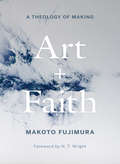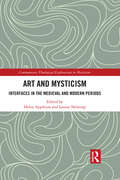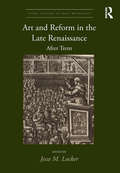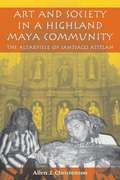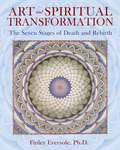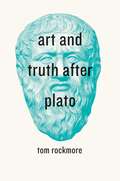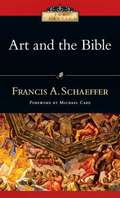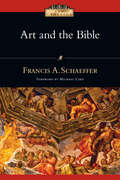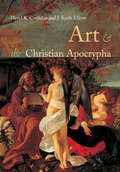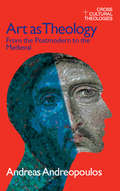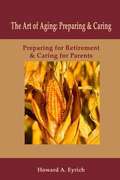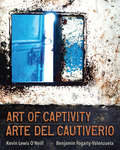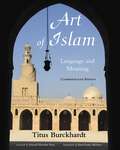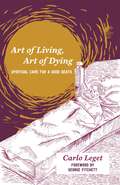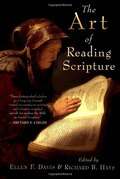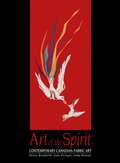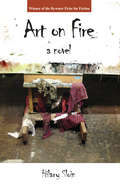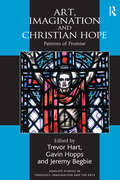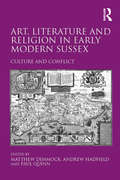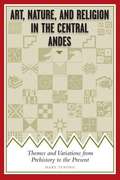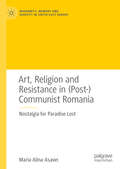- Table View
- List View
Art and Faith: A Theology of Making
by Makoto FujimuraFrom a world-renowned painter, an exploration of creativity&’s quintessential—and often overlooked—role in the spiritual life "Makoto Fujimura is the rare artist whose life has something of the same purifying and galvanizing force of his work. His new book brings those two elements—life and art—even closer together, and is a real tonic for our atomized time." —Christian Wiman Conceived over thirty years of painting and creating in his studio, this book is Makoto Fujimura&’s broad and deep exploration of creativity and the spiritual aspects of &“making.&” What he does in the studio is theological work as much as it is aesthetic work. In between pouring precious, pulverized minerals onto handmade paper to create the prismatic, refractive surfaces of his art, he comes into the quiet space in the studio, in a discipline of awareness, waiting, prayer, and praise. Ranging from the Bible to T. S. Eliot, and from Mark Rothko to Japanese Kintsugi technique, he shows how unless we are making something, we cannot know the depth of God&’s being and God&’s grace permeating our lives. This poignant and beautiful book offers the perspective of, in Christian Wiman&’s words, &“an accidental theologian,&” one who comes to spiritual questions always through the prism of art.
Art and Mysticism: Interfaces in the Medieval and Modern Periods (Contemporary Theological Explorations in Mysticism)
by Louise Nelstrop Helen AppletonFrom the visual and textual art of Anglo-Saxon England onwards, images held a surprising power in the Western Christian tradition. Not only did these artistic representations provide images through which to find God, they also held mystical potential, and likewise mystical writing, from the early medieval period onwards, is also filled with images of God that likewise refracts and reflects His glory. This collection of essays introduces the currents of thought and practice that underpin this artistic engagement with Western Christian mysticism, and explores the continued link between art and theology. The book features contributions from an international panel of leading academics, and is divided into four sections. The first section offers theoretical and philosophical considerations of mystical aesthetics and the interplay between mysticism and art. The final three sections investigate this interplay between the arts and mysticism from three key vantage points. The purpose of the volume is to explore this rarely considered yet crucial interface between art and mysticism. It is therefore an important and illuminating collection of scholarship that will appeal to scholars of theology and Christian mysticism as much as those who study literature, the arts and art history.
Art and Reform in the Late Renaissance: After Trent (Visual Culture in Early Modernity)
by Jesse M. LockerDrawing on recent research by established and emerging scholars of sixteenth- and seventeenth-century art, this volume reconsiders the art and architecture produced after 1563 across the conventional geographic borders. Rather than considering this period a degraded afterword to Renaissance classicism or an inchoate proto-Baroque, the book seeks to understand the art on its own terms. By considering artists such as Federico Barocci and Stefano Maderno in Italy, Hendrick Goltzius in the Netherlands, Antoine Caron in France, Francisco Ribalta in Spain, and Bartolomeo Bitti in Peru, the contributors highlight lesser known "reforms" of art from outside the conventional centers. As the first text to cover this formative period from an international perspective, this volume casts new light on the aftermath of the Renaissance and the beginnings of "Baroque."
Art and Society in a Highland Maya Community
by Allen J. Christenson"Allen J. Christenson offers us in this wonderful book a testimony to contemporary Maya artistic creativity in the shadow of civil war, natural disaster, and rampant modernization. Trained in art history and thoroughly acquainted with the historical and modern ethnography of the Maya area, Christenson chronicles in this beautifully illustrated work the reconstruction of the central altarpiece of the Maya Church of Tz'utujil-speaking Santiago Atitlán, Guatemala. The much-loved colonial-era shrine collapsed after a series of destructive earthquakes in the twentieth century. Christenson's close friendship with the Chávez brothers, the native Maya artists who reconstructed the shrine in close consultation with village elders, enables him to provide detailed exegesis of how this complex work of art translates into material form the theology and cosmology of the traditional Tz'utujil Maya. With the author's guidance, we are taught to see this remarkable work of art as the Maya Christian cosmogram that it is. Although it has the triptych form of a conventional Catholic altarpiece, its iconography reveals a profoundly Maya narrative, replete with sacred mountains and life-giving caves, with the whole articulated by a central axis mundi motif in the form of a sacred tree or maize plant (ambiguity intended) that is reminiscent of well-known ancient Maya ideas. Through Christenson's focused analysis of the iconography of this shrine, we are able to see and understand almost firsthand how the modern Maya people of Santiago Atitlán have remembered the imagined universe of their ancestors and placed upon this sacred framework their received truths in time present. "--Gary H. Gossen, Distinguished Professor Emeritus of Anthropology and Latin American Studies, University at Albany, SUNY
Art and Spiritual Transformation: The Seven Stages of Death and Rebirth
by Finley EversoleThe primal role of art in awakening and liberating the soul of humanity • Presents a seven-stage journey of transformation moving from the darkened soul to the light of spiritual illumination • Provides a meditation practice to experience the spiritual energy embedded within art • Includes artists Alex Grey, Jackson Pollock, Mark Rothko, Walter Gaudnek, and others Art and Spiritual Transformation presents a seven-stage journey from the darkened soul to the light of spiritual illumination that is possible through the world of art. Finley Eversole introduces a meditation practice that moves beyond the visual content of an art form in order to connect with its embedded spiritual energy, allowing the viewer to tap in to the deeper consciousness inherent in the artwork and awaken dormant powers in the depths of the viewer’s soul. Examining modern and postmodern artwork from 1945 onward, Eversole reveals the influences of ancient Egypt, India, China, and alchemy on this art. He draws extensively on philosophy, myth and symbolism, literature, and metaphysics to explain the seven stages of spiritual death and rebirth of the soul possible through art: the experience of self-loss, the journey into the underworld, the experience of the dark night of the soul, the conflict with and triumph over evil, the awakening of new life in the depths of being, and the return and reintegration of consciousness on a higher plane of being, resulting finally in ecstasy, transfiguration, illumination, and liberation. To illustrate these stages, Eversole includes works by abstract expressionists Jackson Pollock, Willem de Kooning, and Mark Rothko and modern visionary artists Alex Grey and Ernst Fuchs, among others, to reveal the powerful and liberating forces art contributes to the transformation and evolution of human consciousness.
Art and Truth after Plato
by Tom RockmoreDespite its foundational role in the history of philosophy, Plato’s famous argument that art does not have access to truth or knowledge is now rarely examined, in part because recent philosophers have assumed that Plato’s challenge was resolved long ago. In Art and Truth after Plato, Tom Rockmore argues that Plato has in fact never been satisfactorily answered—and to demonstrate that, he offers a comprehensive account of Plato’s influence through nearly the whole history of Western aesthetics. Rockmore offers a cogent reading of the post-Platonic aesthetic tradition as a series of responses to Plato’s position, examining a stunning diversity of thinkers and ideas. He visits Aristotle’s Poetics, the medieval Christians, Kant’s Critique of Judgment, Hegel’s phenomenology, Marxism, social realism, Heidegger, and many other works and thinkers, ending with a powerful synthesis that lands on four central aesthetic arguments that philosophers have debated. More than a mere history of aesthetics, Art and Truth after Plato presents a fresh look at an ancient question, bringing it into contemporary relief.
Art and the Bible
by Francis A. SchaefferMany Christians, wary of creating graven images, have steered clear of artistic creativity. But the Bible offers a robust affirmation of the arts. The human impulse to create reflects our being created in the image of a creator God. Art and the Bible has been a foundational work for generations of Christians in the arts. In this book's classic essays, Francis Schaeffer first examines the scriptural record of the use of various art forms, and then establishes a Christian perspective on art. With clarity and vigor, Schaeffer explains why "the Christian is the one whose imagination should fly beyond the stars."
Art and the Bible: Two Essays (IVP Classics)
by Francis A. Schaeffer"The lordship of Christ should include an interest in the arts," writes Francis Schaeffer. "A Christian should use these arts to the glory of God, not just as tracts, mind you, but as things of beauty to the praise of God." Many Christians, wary of creating graven images, have steered clear of artistic creativity. But the Bible offers a robust affirmation of the arts. The human impulse to create reflects our being created in the image of a creator God. Art and the Bible has been a foundational work for generations of Christians in the arts. In this book's classic essays, Francis Schaeffer first examines the scriptural record of the use of various art forms, and then establishes a Christian perspective on art. With clarity and vigor, Schaeffer explains why "the Christian is the one whose imagination should fly beyond the stars."
Art and the Christian Apocrypha
by David R. Cartlidge J. Keith ElliotThe Christian canon of scripture, known as the New Testament, excluded many of the Church's traditional stories about its origins. Although not in the Bible, these popular stories have had a powerful influence on the Church's traditions and theology, and a particularly marked effect on visual representations of Christian belief. This book provides a lucid introduction to the relationship between the apocryphal texts and the paintings, mosaics, and sculpture in which they are frequently paralleled, and which have been so significant in transmitting these non-Biblical stories to generations of churchgoers.
Art and the Church: Ecclesiastical Encounters with Contemporary Art
by Jonathan Koestle-CateA vibrant critical exchange between contemporary art and Christianity is being increasingly prompted by an expanding programme of art installations and commissions for ecclesiastical spaces. Rather than 'religious art' reflecting Christian ideology, current practices frequently initiate projects that question the values and traditions of the host space, or present objects and events that challenge its visual conventions. In the light of these developments, this book asks what conditions are favourable to enhancing and expanding the possibilities of church-based art, and how can these conditions be addressed? What viable language or strategies can be formulated to understand and analyse art's role within the church? Focusing on concepts drawn from anthropology, comparative religion, art theory, theology and philosophy, this book formulates a lexicon of terms built around the notion of encounter in order to review the effective uses and experience of contemporary art in churches. The author concludes with the prognosis that art for the church has reached a critical and decisive phase in its history, testing the assumption that contemporary art should be a taken-for-granted element of modern church life. Art and the Church: A Fractious Embrace uniquely combines conceptual analysis, critical case studies and practical application in a rigorous and inventive manner, dealing specifically with contemporary art of the past twenty-five years, and the most recent developments in the church's policies for the arts.
Art and the Religious Image in El Greco’s Italy
by Andrew R. CasperArt and the Religious Image in El Greco’s Italy is the first book-length examination of the early career of one of the early modern period’s most notoriously misunderstood figures. Born around 1541, Domenikos Theotokopoulos began his career as an icon painter on the island of Crete. He is best known, under the name “El Greco,” for the works he created while in Spain, paintings that have provoked both rapt admiration and scornful disapproval since his death in 1614. But the nearly ten years he spent in Venice and Rome, from 1567 to 1576, have remained underexplored until now. Andrew Casper’s examination of this period allows us to gain a proper understanding of El Greco’s entire career and reveals much about the tumultuous environment for religious painting after the Council of Trent.Art and the Religious Image in El Greco’s Italy is a new book in the Art History Publication Initiative (AHPI), a collaborative grant from the Andrew W. Mellon Foundation. Thanks to the AHPI grant, this book will be available in popular e-book formats.
Art and the Religious Image in El Greco’s Italy
by Andrew R. CasperArt and the Religious Image in El Greco’s Italy is the first book-length examination of the early career of one of the early modern period’s most notoriously misunderstood figures. Born around 1541, Domenikos Theotokopoulos began his career as an icon painter on the island of Crete. He is best known, under the name “El Greco,” for the works he created while in Spain, paintings that have provoked both rapt admiration and scornful disapproval since his death in 1614. But the nearly ten years he spent in Venice and Rome, from 1567 to 1576, have remained underexplored until now. Andrew Casper’s examination of this period allows us to gain a proper understanding of El Greco’s entire career and reveals much about the tumultuous environment for religious painting after the Council of Trent.Art and the Religious Image in El Greco’s Italy is a new book in the Art History Publication Initiative (AHPI), a collaborative grant from the Andrew W. Mellon Foundation. Thanks to the AHPI grant, this book will be available in popular e-book formats.
Art as Theology: From the Postmodern to the Medieval
by Andreas AndreapoulosReligion and spirituality are key aspects of the contemporary art scene. Following Ronald Barthes' 'death of the author' - which argued for the dissociation of work from creator - works of art have withdrawn as independent objects, giving way to a growing religious awareness or practice. 'Art and Theology' examines the connection between art and religion in ancient Jewish drama, Greek tragedy, the Renaissance, the Byzantine icon and the medieval cathedral. The book explores how art lost its sacred character in the late Middle Ages and how the current withdrawal or 'death' of art and the fusion of the limits of art and life are consistent with the medieval view of the religious icon.
Art before the Law
by Ruth RonenEver since Plato expelled the poets from his ideal state, the ethics of art has had to confront philosophy's denial of art's morality. In Art before the Law, Ruth Ronen proposes a new outlook on the ethics of art by arguing that art insists on this tradition of denial, affirming its singular ethics through negativity.Ronen treats the mechanism of negation as the basis for the relationship between art and ethics. She shows how, through moves of denial, resistance, and denouncement, art exploits its negative relation to morality. While deception, fiction, and transgression allegedly locate art outside morality and ethics, Ronen argues they enable art to reveal the significance of the moral law, its origins, and the idea of the good. By employing the thought of Freud and Lacan, Ronen reconsiders the aesthetic tradition from Plato through Kant and later philosophers of art in order to establish an ethics of art. An interdisciplinary study, Art before the Law is sure to be of interest both to academic philosophers and to those interested in psychoanalytic theory and practice.
Art of Aging: Preparing and Caring: Preparing for Retirement & Caring for Parents
by Howard A. EyrichThere are two classes of sandwich generations today. One group is those raising children and caring for parents. The other is the senior generation finding itself caught between helping adult children (often raising or helping to raise grandchildren) and caring for elderly parents. Further, many are contemplating their own retirement and making plans for that season of their lives. This book is designed to be a practical handbook of valuable resources regarding the following questions:·How is God involved in aging?·How do I prepare to grow old?·How do I grow old gracefully?·How do I care for aging parents?·How do I decide when to use a nursing home?·How do I choose a nursing home?·How do I access social help?“This book is proof that an encyclopedia can be interesting, comprehensive and intensely practical, without being enormous in size. Dr. Eyrich has marvelously given us everything we really need to know on the subject of aging from a biblical perspective. The evaluation forms included in the book can lend concrete assistance for those difficult decisions concerning loved ones. This is the most helpful book I’ve seen on the subject.”Dr. Stuart ScottAssoc. Professor of Biblical CounselingSouthern Baptist Theological Seminary
Art of Captivity / Arte del Cautiverio (G - Reference,information And Interdisciplinary Subjects Ser.)
by Kevin Lewis O'Neill Benjamin Fogarty-ValenzuelaThrough a series of rich photographs, Art of Captivity / Arte del Cautiverio tells a compelling story about the war on drugs in Central America. The book focuses on the country of Guatemala, now the principle point of transit for the cocaine that is produced in the Andes and bound for the United States and Canada. Alongside a spike in the use of crack cocaine, Guatemala City has witnessed the proliferation of Pentecostal drug rehabilitation centers. The centers are sites of abuse and torment, but also lifesaving institutions in a country that does not provide any other viable social service to those struggling with drug dependency. Art of Captivity / Arte del Cautiverio explores these centers as architectural forms, while also showcasing the cultural production that takes place inside them, including drawings and letters created by those held captive. This stunning work of visual ethnography humanizes those held inside these centers, breaks down stereotypes about drug use, and sets the conditions for a hemispheric conversation about prohibitionist practices – by revealing intimate portraits of a population held hostage by a war on drugs.
Art of Islam, Language and Meaning
by Titus BurckhardtKnown as an expert on Islam, Sufism, and Islamic arts & crafts, Burckhardt presents in-depth analyses of seminal examples of Islamic architecture, from Spain and Morocco to Persia and India. He examines Koranic calligraphy and illumination, arabesque, carpets and rugs, Persian miniatures, and much more while making illuminating comparisons with Christian, Hindu, and Buddhist art. Beautifully illustrated in color, this masterpiece is presented in a revised, commemorative edition containing 285 new illustrations and a new Introduction.
Art of Living, Art of Dying: Spiritual Care for a Good Death
by George Fitchett Carlo LegetWithout an appropriate spiritual care model, it can be difficult to discuss existential questions about death and dying with people who are confronted with life-threatening or incurable diseases. This book offers a simple framework for interpreting existential questions with patients and helping them to cope in end-of-life situations, with illustrative examples from practice. Building on the medieval Ars moriendi tradition, the author introduces a contemporary art of dying model. It shows how to discuss existential questions in a post-Christian context, without moralising death or telling people how they should feel. Written in a straightforward manner, this is a helpful resource for chaplains and clergy, and those with no formal spiritual training, including counsellors, doctors, nurses, allied healthcare workers and other professionals who come into contact with patients in hospitals and hospices.
Art of Reading Scripture
by Richard B. Hays Ellen F. DavisThe difficulty of interpreting the Bible is felt all over today. Is the Bible still authoritative for the faith and practice of the church? If so, in what way? What practices of reading offer the most appropriate approach to understanding Scripture? The church's lack of clarity about these issues has hindered its witness and mission, causing it to speak with an uncertain voice to the challenges of our time. <p><p> This important book is for a twenty-first-century church that seems to have lost the art of reading the Bible attentively and imaginatively. The Art of Reading Scripture is written by a group of eminent scholars and teachers seeking to recover the church's rich heritage of biblical interpretation in a dramatically changed cultural environment. Asking how best to read the Bible in a postmodern context, the contributors together affirm up front "Nine Theses" that provide substantial guidance for the church. The essays and sermons that follow both amplify and model the approach to Scripture outlined in the Nine Theses. <p><p> Lucidly conceived, carefully written, and shimmering with fresh insights, The Art of Reading Scripture proposes a far-reaching revolution in how the Bible is taught in theological seminaries and calls pastors and teachers in the church to rethink their practices of using the Bible.
Art of the Spirit: Contemporary Canadian Fabric Art
by Helen Bradfield Joan Pringle Judy RidoutRich colours and arresting designs capture the mood of celebration and joy that characterizes this photographic record of contemporary religious works of art. Chosen for their excellence in design and stitchery, these works represent the achievements of artists who have created art, in fabric, for places of worship. This book celebrates this important artistic expression, a significant part of our heritage. Pieces are selected from communities across Canada: from a small parish on a Micmac reserve in Nova Scotia to a large urban synagogue in Vancouver; from the igloo-shaped cathedral in Iqaluit to a suburban church nestled beside a wildlife march in southwestern Ontario.
Art on Fire
by Hilary SloinArt on Fire is the apparent biography of subversive painter Francesca deSilva, the founding foremother of "pseudorealism," who lived hard and died young. But in the tradition of Vladimir Nabokov's acclaimed novel Pale Fire, it's a fiction from start to finish. It opens with Francesca's early life. We learn about her childhood love, the chess genius Lisa Sinsong, as well as her rivalry with her brilliant sister Isabella, who publishes an acclaimed volume of poetry at the age of twelve. She compensates for the failings of her less than attentive parents by turning to her grandmother who is loyal and adoring until she learns Francesca is a lesbian, when she rejects her. Francesca flees to a ramshackle cabin in Wellfleet, Massachusetts, working weekends at the flea market. She breaks into the gloomy basement of a house, where she begins her life as a painter. Much to her confusion and even dismay, fame comes quickly. Interspersed with Francesca's narrative are thirteen critical "essays" on the paintings of Francesca deSilva by critics, academics, and psychologists--essays that are razor-sharp satires on art, lesbian life, and the academic world, puncturing pretentiousness with every paragraph. Art on Fire is a darkly comic, pitch-perfect, and fearless satire on the very art of biography itself. Art on Fire is the latest winner of the Bywater Prize for Fiction and was a finalist for the Heekin Foundation Award, the Dana Awards, and the Story Oaks Prize. It was mistakenly awarded the nonfiction prize in the Amherst Book and Plow Competition.
Art, Imagination and Christian Hope: Patterns of Promise (Routledge Studies in Theology, Imagination and the Arts)
by Gavin HoppsIn hope, Christian faith reconfigures the shape of what is familiar in order to pattern the contours of God's promised future. In this process, the present is continuously re-shaped by ventures of hopeful and expectant living. In art, this same poetic interplay between past, present and future takes specific concrete forms, furnishing vital resources for sustaining an imaginative ecology of hope. This volume attends to the contributions that architecture, drama, literature, music and painting can make, as artists trace patterns of promise, resisting the finality of modernity's despairing visions and generating hopeful living in a present which, although marked by sin and death, is grasped imaginatively as already pregnant with future.
Art, Literature and Religion in Early Modern Sussex: Culture and Conflict
by Andrew HadfieldArt, Literature and Religion in Early Modern Sussex is an interdisciplinary study of a county at the forefront of religious, political and artistic developments in early-modern England. Ranging from the schism of Reformation to the outbreak of Civil War, the volume brings together scholars from the fields of art history, religious and intellectual history and English literature to offer new perspectives on early-modern Sussex. Essays discuss a wide variety of topics: the coherence of a county divided between East and West and Catholic and Protestant; the art and literary collections of Chichester cathedral; communities of Catholic gentry; Protestant martyrdom; aristocratic education; writing, preaching and exile; local funerary monuments; and the progresses of Elizabeth I. Contributors include Michael Questier; Nigel Llewellyn; Caroline Adams; Karen Coke; and Andrew Foster. The collection concludes with an Afterword by Duncan Salkeld (University of Chichester). This volume extends work done in the 1960s and 70s on early-modern Sussex, drawing on new work on county and religious identities, and setting it into a broad national context. The result is a book that not only tells us much about Sussex, but which also has a great deal to offer all scholars working in the field of local and regional history, and religious change in England as a whole.
Art, Nature, and Religion in the Central Andes: Themes and Variations from Prehistory to Present
by Mary StrongFrom prehistory to the present, the Indigenous peoples of the Andes have used a visual symbol system—that is, art—to express their sense of the sacred and its immanence in the natural world. Many visual motifs that originated prior to the Incas still appear in Andean art today, despite the onslaught of cultural disruption that native Andeans have endured over several centuries. Indeed, art has always been a unifying power through which Andeans maintain their spirituality, pride, and culture while resisting the oppression of the dominant society. In this book, Mary Strong takes a significantly new approach to Andean art that links prehistoric to contemporary forms through an ethnographic understanding of Indigenous Andean culture. In the first part of the book, she provides a broad historical survey of Andean art that explores how Andean religious concepts have been expressed in art and how artists have responded to cultural encounters and impositions, ranging from invasion and conquest to international labor migration and the internet. In the second part, Strong looks at eight contemporary art types—the scissors dance (danza de tijeras), home altars (retablos), carved gourds (mates), ceramics (ceramica), painted boards (tablas), weavings (textiles), tinware (hojalateria), and Huamanga stone carvings (piedra de Huamanga). She includes prehistoric and historic information about each art form, its religious meaning, the natural environment and sociopolitical processes that help to shape its expression, and how it is constructed or performed by today’s artists, many of whom are quoted in the book.
Art, Religion and Resistance in: Nostalgia for Paradise Lost (Modernity, Memory and Identity in South-East Europe)
by Maria Alina AsaveiThis book illuminates the interconnections between politics and religion through the lens of artistic production, exploring how art inspired by religion functioned as a form of resistance, directed against both Romanian national communism (1960-1989) and, latterly, consumerist society and its global market. It investigates the critical, tactical and subversive employments of religious motifs and themes in contemporary art pieces that confront the religious ‘affair’ in post-communist Romania. In doing so, it addresses a key gap in previous scholarship, which has paid little attention to the relationship between religious art and political resistance in communist Central and South-East Europe.
